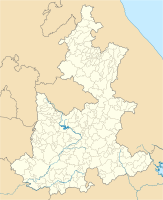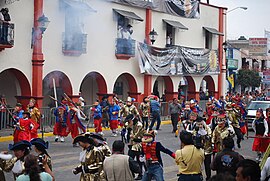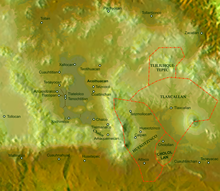Huejotzingo
| Huejotzingo | ||
|---|---|---|
|
Coordinates: 19 ° 9 ′ N , 98 ° 24 ′ W Huejotzingo on the map of Puebla
|
||
| Basic data | ||
| Country | Mexico | |
| State | Puebla | |
| Municipio | Huejotzingo | |
| Residents | 25,684 (2010) | |
| Detailed data | ||
| height | 2260 m | |
| Post Code | 74160 | |
| prefix | (+52) 227 | |
| Time zone | UTC −6 | |
| Website | ||
| Huejotzingo Carnival | ||
Huejotzingo is a city in the northwestern part of the Mexican Puebla in the wide valley basin of the Río Atoyac around 24 km northwest of the capital Puebla . The name comes as Huexotzinco ( Huexōtzinco ) from the Nahuatl, is formed from the noun huexōtl , pasture, the diminutive suffix -tzin and the locative suffix -co and can be translated as "Kleiner Weidenort".
Huejotzingo has a good 25,000 inhabitants and is the administrative seat of the Municipio Huejotzingo in the Zona Metropolitana de Puebla-Tlaxcala .
history
Pre-Hispanic time
Sources for the pre-Hispanic period are primarily the reports of Indian and Spanish authors from the colonial period, which are based on native traditions. Colonial documents from the region occasionally shed some light on the pre-Hispanic period, but overall the impression arises that from a local point of view, the chaotic conditions of the last years before the Spanish conquest should not be mentioned if possible.
supremacy
In the middle of the 14th century there was rivalry over supremacy in the region, with the Huexotzinca able to count on the support of their related Acolhuaque from the basin of Mexico. Tlaxcallan escaped defeat thanks to the help of its southern neighbors Cholollan , Cuauhtinchan and Totimehuacan . One consequence of this development was that in particular the political power and territorial expansion of Cholollan was severely restricted. Overall, afterwards - the exact dating is controversial - a period of balanced strength and stability set in, whereby Huexotzinco may have assumed the role of a primus inter pares . Joint war undertakings were directed, among other things, against Chalco in the basin of Mexico and Cuauhquechollan , whose main town was then on the site of the modern city of Atlixco . Since Cuauhquechollan was defeated, it had to be relocated around 20 km to the southwest, its previous territory in the particularly fertile valley area was divided between Huexotzinco and Calpan - a structure that lasted until the colonial era. The expansion brought Huexotzinco into direct contact with Totimehuacan, which it defeated after initial failures. The emergence of local power, which became visible as a result, provoked reactions in the basin of Mexico: Tlatelolco intervened and conquered Cuauhtinchan, from where a faction of the small multiethnic state called for help. Tlatelolco subsequently established a new ruling dynasty in Cuauhtinchan.
Huexotzinco and Tlaxcallan initially remained neutral in relation to the changes in the Mexico basin, through which the Tepaneks rose to become the leading power. Nevertheless, Huexotzinco offered asylum to the designated ruler of Tetzcoco , Nezahualcóyotl , who had fled after his father's murder . This led to an interference of Huexotzinco in the power dispute of Tetzcoco on the side of the strengthening opponents of the Tepaneks, Tenochtitlan and Tlatelolco. With this crucial support, Nezahualcoyotl was able to regain its territory. However, Huexotzinco and Tlaxcallan did not maintain the alliance with the new Triple Alliance in the basin of Mexico (Tenochtitlán, Texcoco and Tlacopan ), but now offered refuge for the opposing party who had fled Texcoco.
Conflicts with the Aztec Triple Alliance
As part of its active expansion policy, the Central Mexican Triple Alliance undertook various attempts from the middle of the 15th century, especially under Moctezuma I , to secure power beyond the Popocatépetl and Iztaccíhuatl volcanic chains or at least to control the trade routes to and in the tropical coastal country. Huexotzinco, Cholollan and Tlaxcallan therefore intervened in Coaixtlahuacan and in Cuetlaxtlan and Ahuilizapan in what is now Veracruz , albeit in vain. At about the same time, Tenochtitlan conquered the neighboring city of Tepeyacac , again at the request of the Aztec faction in Cuauhtinchan , which was then part of the Aztec tribute empire. With this, and through further conquests of smaller political units, Huexotzinco and Tlaxcallan were practically encircled. The small rulers now under Aztec rule carried out numerous smaller attacks against Huexotzinco, Tlaxcallan and their allies, initially against Totimehuacan, whose inhabitants had to flee. Refugees were also accepted from other areas, especially after the conquest of Chalco by the Aztecs in 1465.
Flower wars
Since both sides were apparently neither strong enough nor hoped to gain from further conquests, the peculiar institution of the wars of flowers arose , through which the balance of power was not changed significantly despite regular military activities in the surrounding area. In the eyes of the Aztecs, the flower wars with Tlaxcallan and especially Huexotzinco were particularly important because the warriors of these cities were famous for their bravery. The Flower Wars, however, should not be dismissed as little serious; on one occasion shortly before the end of the 15th century, the Aztec forces suffered one of their rare defeats and a number of members of their ruling family were killed.
Decline
Soon thereafter there was a development that was only known in fragments and was apparently triggered by the death of the ruler Chiaucoatl of Chiautzingo, one of the lords within Huexotzinco. His son, Toltecatzin, got into a quarrel with the priests of the local deity Mixcoatl-Camaxtli, which led to a civil war that was to the detriment of Toltecatzin and his followers, who had to flee to Amaquemecan (in Chalco). However, the civil war seems to have continued. The resulting weakening was used by Tlaxcallan to invade sparsely populated areas in the northern part of the shared border region. This resulted in a bloody war, during which Tlaxcallan repeatedly destroyed the crops in Huexotzinco and caused famine there. Many people from Huexotzinco saw no other way out than to flee into the basin of Mexico, including to Tenochtitlán. They were led by two of their rulers, Tecayehuatl and Xayacamachan, and were warmly received in Tenochtitlán. Moctezuma II transferred troops to Huexotzinco, where they set up a camp above the town. The fighting lasted for several years until Tlaxcallan was finally defeated and driven from Huexotzinco. After that, shortly before the Spaniards arrived in Mexico, many Huexotzinca returned home. While the Tecayehua group apparently left with the consent of the Aztec ruler, the Xayacamachan group seems to have secretly escaped, but was caught and killed near Amaquemecan. A cause in the background for disputes seems to have been the refusal of the Huexotzinca to hand over the image of their god Camaxtli to the Aztecs. Since these housed the images of the deities of subject areas in their temples, the refusal to have been a diplomatic form of expressing that one did not feel subject to. The sources say that the Huexotzinca killed their Aztec wives from the time of their exile and their children after their return. The alliance between Huexotzinco, Tlaxcallan and Cholollan, which was openly directed against the Aztec Triple Alliance, then revived. This became evident when Tecayehuatl declined an invitation to attend a temple dedication ceremony in Tenochtitlán. The result was another outbreak of war, which culminated on Mount Ahuayocan (today: Cerro Coxtocan near San Martín Texmulucan ), with the Aztecs suffering a heavy defeat and the Aztec garrison being wiped out. The second highest dignitary of Tlatelolco, the tlacatecatl Totozaca, fell into the hands of Huexotzinco , who was then sacrificed. The Tlaxcalteks under Xicoténcatl were the big winners, while Huexotzinco has apparently lost its independence for good and the Tenochtitlán-friendly faction of the Tecayehuatl has disappeared into insignificance. From now on, Quecehuatl is named as the ruler of Huexotzinco without any further details being known about him.
structure
The political center of Huexotzinco, like some others in the region, consisted of four closely neighboring centers, namely Tecpan (actually Huexotzinco), Xaltepetlapan, Almoyahuacan and Ocotepec. They were all in a relatively protected position on the lower foothills of the Iztaccíhuatl volcano, separated by gorges up to 100 m deep. Their rulers exercised power in Huexotzinco together, although a certain dominance seems to have changed.
Conquista
The penetration of the Spanish conquistadors happened at the most unfavorable moment imaginable for the Aztec Triple Alliance, when the forces in the areas independent of the Aztecs were deeply weakened by internal disputes and the now dominant power, Tlaxcallan, was unable to effectively resist. In addition, the memory of the last few wars with the Aztecs was so fresh that any chance to break free from their grip and pressure must be welcome. When the Tlaxcalteks allied themselves with Hernán Cortés against the Aztecs, the Huexotzinca also formed an alliance with the Spaniards. This alliance lasted until the victory over the Aztecs.
From Tlaxcallan, where the Spaniards stayed between September 23 and October 13, 1519, they moved to Cholollan , where on October 18 the well-known massacre of the local population took place. From there, the Spanish conquering army moved on November 2, 1519 through the territory of Huexotzinco via the place Los Ranchos de Itzcalpan (today: Los Ranchos) and on the following day via the basin, now called Paso de Cortés , between the Popocatépetl and the Iztaccíhuatl to Tenochtitlan . Auxiliary troops and porters from Tlaxcallan and Huexotzinmco accompanied them. Before Tenochtitlan was finally taken, countless Indian helpers transported the boats, built in Tlaxcallan in October 1520, via the town of Tetzmollocan, now Santa María Texmelucan, and the Paso de Río Frío to Lake Texcoco .
Colonial times
Shortly after the conclusion of the conquest of Tenochtitlan , Cortés began to raise pigs on a large scale in the area of Huejotzingo, which he claimed for himself.
Shortly after the arrival of the first twelve Franciscan monks in Mexico in the summer of 1524, the first monastery dedicated to the Archangel Michael was built in Huexotzinco . It seems that this convent did not exist in its current location from the beginning, but in one of the main towns of Huexotzingo. Buildings can be found at the current location around 1545, and the year 1550 is carved into the roof of one of the chapels in the courtyard. The construction work on the monastery dragged on for several decades. The monastery is one of the mission stations at the foot of the Popocatépetl and was included in the Unesco World Heritage Site in 1994.
Under the rule of the "First Audiencia" (Primer Audiencia), the supreme judicial and administrative body set up by the Spanish king (since 1527), with its president Beltrán Nuño de Guzmán , who took over all the goods of the Cortés (who was in Spain from 1528) confiscated, Huejotzingo suffered from their huge demands for tribute and other attacks. The elected but not yet consecrated Bishop Juan de Zumárraga and other Franciscans, including Motolinia in a leading position, take the side of the local population and grant their asylum in the monastery. The disputes continue even after Huejotzingo was given as encomienda to the conquistador Diego de Ordaz , the first to climb the Popocatepetl. In December 1529, Nuño de Guzmán forced a large number of warriors from Huejotzingo to accompany him on his expedition to conquer northwestern Mexico, none of whom survived the procession.
In 1532, after Diego de Ordaz's death on an expedition in Peru, the Encomienda Huejotzingo fell to the Spanish crown. In the next year, Huejotzingo joins the Spanish settlers of the recently founded city of Puebla in the Atlixco Land area . The long-distance traffic route (“ camino real ”) via Puebla to the coast is also being expanded.
By order of the viceroy Luis de Velasco on August 26, 1552, the population of the main towns and the numerous scattered settlements were moved to the new city that began to emerge around the monastery. The resettlement was not very successful, as many people preferred to return to their old homes more or less secretly, so that with few exceptions they still exist today. A division of the city by the main axes into four quarters corresponds to the old main towns to this day, as do the chapels in the forecourt of the monastery church.
As a reward for the resettlement, the Spanish King Carlos I awarded the town the title of city and a coat of arms in August 1553 . In 1559 one of the town's mills was completed on the nearby Río Xochiac.
Unlike Tlaxcala, which received default treatment for helping the Spaniards during the colonial period, Huexotzinco had no privileges. In the 1540s, an Indian local government based on the Spanish model was established in Huexotzinco, consisting of a city council (Cabildo) under the leadership of a governor (Gobernador). This was chosen from the nobility of the former main towns (now called Cabeceras) and should in principle rotate between them.
Individual evidence
- ↑ Doris Heyden: Un cronista habla de Huexotzinco . In: Symposium internacional de investigación de Huexotzinco . Instituto Nacional de Antropología e Historia, México, DF 1997. ISBN 970-18-0663-8 , pp. 95-108; about Diego Durán
- ↑ Ursula Dyckerhoff: La Región del Alto Atoyac - la época prehispánica . In: Hanns J. Prem: Milpa y hacienda, tenencia de la tierra indígena y española en la Cuenca del Alto Atoyac, Puebla, México (1520-1650). Franz Steiner, Wiesbaden 1978, ISBN 3-515-02698-3 , pp. 18-34.
- ^ Bernal Díaz del Castillo: History of the Conquest of Mexico , 1988, p. 500
literature
- Claude Nigel Byam Davies : Los señoríos independientes del imperio azteca . Instituto Nacional de anthropología e Historia, México 1968.
- Ursula Dyckerhoff : Grupos étnicos y estratificación socio-política, tentativa de explicación histórica . In Indiana Vol. 19/20. ISSN 0341-8642 . Pp. 155-196.
- Hanns J. Prem : The Aztecs. History - culture - religion . Verlag CH Beck, Munich 2006, ISBN 3-406-45835-1 .
- Hanns J. Prem: History of ancient America. Oldenbourg, Munich 1989 (2nd revised edition 2007). ISBN 3-486-53032-1 .






